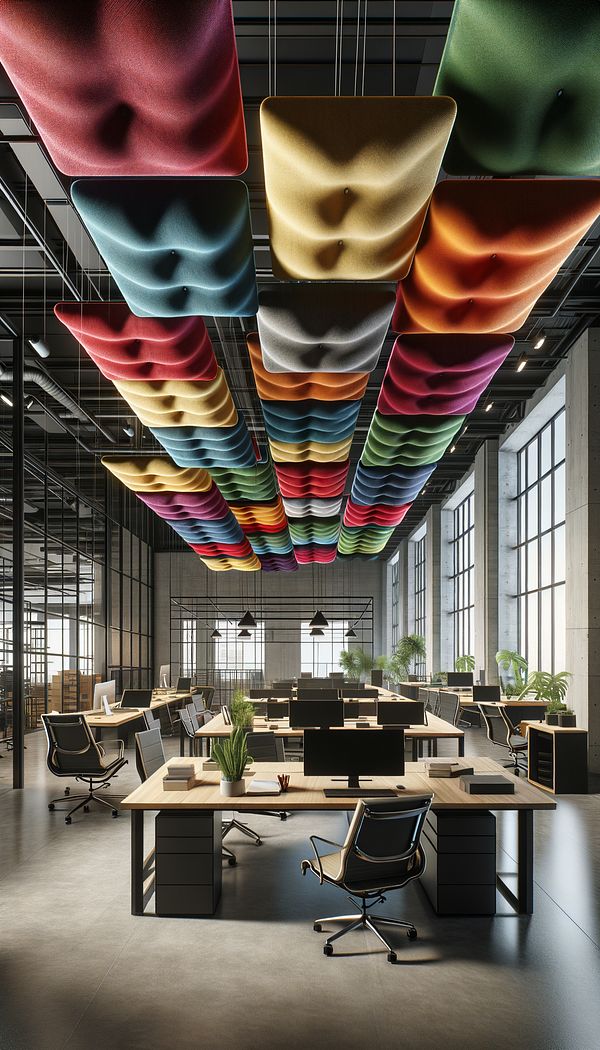What is a Baffle?
A baffle is a device used to obstruct, break up, or redirect sound waves.
Description
In the context of interior design, a baffle refers specifically to an architectural feature or device designed to mitigate sound transmission through spaces by obstructing, breaking up, or redirecting sound waves. Typically, baffles are used in commercial and public buildings, such as theaters, concert halls, and open-plan offices, where controlling acoustics is crucial to the space's functionality and comfort.
Baffles can come in various forms, including vertical panels suspended from ceilings, wall-mounted units, or even freestanding elements within a room. These can be made from a range of materials--such as fabric, metal, wood, or foam--each contributing differently to sound absorption or deflection. Their design not only aids in achieving the desired acoustic properties but can also contribute to the overall aesthetic of the space.
By strategically placing these baffles within a room, designers can effectively manage sound levels, reduce echo, and enhance speech intelligibility. This makes baffle installations a critical aspect of space planning and layout, particularly in environments where clear communication or a specific acoustic atmosphere is required. Integrating baffles into a design plan allows for the creation of spaces that are both functionally and visually appealing.
Usage
Baffles are commonly found in environments where sound control is a priority, such as theatres, concert halls, lecture rooms, libraries, and open-plan offices. By reducing noise pollution and enhancing acoustics, baffles contribute to creating more comfortable and functional spaces. Their use is not limited to commercial or public buildings; baffles can also be integrated into residential spaces, such as home studios or entertainment rooms, to improve sound quality.
FAQs
-
Can baffles be decorative?
Yes, baffles can be both functional and decorative. They come in various shapes, sizes, colors, and materials, allowing them to contribute to the space's overall aesthetic while performing their primary function of sound control.
-
Are there eco-friendly options for baffles?
Absolutely. Many manufacturers offer baffles made from sustainable materials like recycled fabric, wood, and bio-based foams. These options provide the same acoustic benefits while also supporting environmental sustainability.
-
How are baffles installed?
Installation methods for baffles vary depending on their design and the specifics of the space. They can be suspended from ceilings using wires or mounted directly onto walls. Some baffles are designed to stand freely on the floor, providing flexibility in placement and usage.
Practical Application
When incorporating baffles into a design scheme, consider the size and shape of the space, along with the specific sound-control needs. For instance, in a large open-plan office, hanging baffles from the ceiling at varied heights can help break up sound transmission across the space, while also adding a dynamic visual element. In a home cinema, wall-mounted baffles with absorbent materials can enhance the audio experience by reducing sound reflections. Moreover, the choice of material and color of the baffles can be aligned with the overall interior design theme, making them a functional yet decorative feature.
-
Architectural Elements199 articles
-
Design Styles478 articles
-
Lighting111 articles
-
Sustainability & Eco-Friendly Design69 articles
-
Wall & Ceiling Treatments35 articles
-
Acorn TurningAcorn turning is a decorative woodworking technique.
-
Building EnvelopeThe physical barrier that separates the interior of a building from the exterior environment.
-
Cushion DrawerA cushion drawer is a drawer that features a built-in cushion or pad, enhancing comfort and functionality.
-
Pegged FurniturePegged furniture is furniture that has been assembled using pegs to join its parts.
-
Wellington ChestA tall, narrow chest of drawers, often featuring a locking mechanism.
